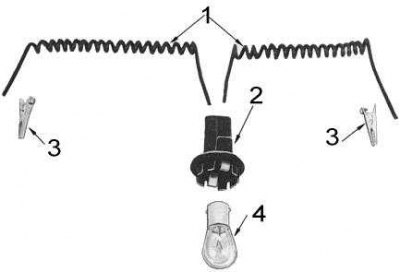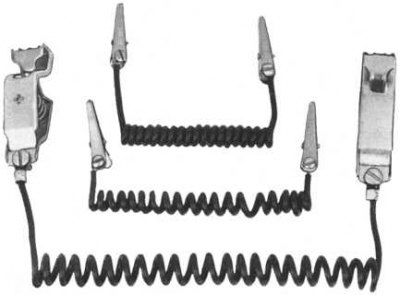How to make a probe lamp
Incandescent probe lamp
When servicing electrical systems, a probe lamp is the most effective tool to check for continuity in a circuit under load.
The simplest probe lamp can be made from a pair of pieces of 4 mm wire, a pair of clamps such as "crocodile" and equipped with two contacts of the socket and a 1-filament lamp, designed for a supply voltage of 12 V with a 2-pin base (see accompanying illustration).

1 - wires; 2 - cartridge; 3 - clamp; 4 - lamp
1. Strip the wires from both ends to a convenient length.
2. Solder one end of each wire with clips of type "crocodile".
3. Connect the opposite ends of the wires to the cartridge terminals, making sure that they do not come into contact with each other and with the cartridge body.
4. Install the lamp base in the socket.
5. Connect the clamps to the 12-volt battery terminals to check that the assembly is functioning properly. The lamp should light up.
LED probe lamp
Using a conventional probe lamp (with filament) to check for continuity in circuits that include electronic components can lead to the failure of such components due to the flow of a sufficiently high current through them. The compilers of this Guide recommend the use of an LED-based test lamp in such cases (LED).
The simplest LED probe lamp can be made from a piece of 3 mm wire of a suitable length, a clamp of the type "crocodile", LED and resistor 1/4 W, 560 Ohm. In addition, you will need a casing, which is quite simple to make from an old ballpoint pen and a thin metal rod (piece of wire), pointed at one end. Make sure that the connection of the anode and cathode of the LED is done exactly as shown in the illustration.

1 - glue; 2 - LED; 3 - diode cathode; 4 - diode anode; 5 - pen case; 6 - wire; 7 - resistor; 8 - probe (pointed metal rod); 9 - clamp
Note. When using a probe lamp on an LED, it should be remembered that the diode passes current in only one direction, therefore the lamp will only function if the wire clamp is connected to the negative side of the circuit, and the probe to the positive side.
1. Solder a piece of wire to the LED cathode (the cathode terminal is noticeably shorter than the anode terminal adjacent to it at the end of the diode).
2. Solder a 560 ohm resistor to the anode.
3. Solder a short piece of wire between the resistor and the probe.
4. Drill a hole in the wall of the pen case and let the wire coming from the cathode into it.
5. Using glue, secure the probe to the body of the pen by pushing its end into the bottom hole.
6. Solder a clamp of the type "crocodile".
7. The LED can be fixed in a cork that fits snugly into the top hole of the pen body. To observe the diode, a viewing hole must be made in the plug.
How to make a jumper wire
When diagnosing malfunctions of electrical system components, it is very useful to have a jumper wire at hand.
1. Strip a suitable length of 4 mm wire from both ends.

2. Attach type clamps to both ends of the wire "crocodile" (solder them, or fix them in the terminals with screws). Examples of jumper wires of various lengths are shown in the accompanying illustration.
3. Check the jumper wire for continuity, to do this, disconnect one of the wires from the battery and connect a jumper wire between the battery terminal and the wire tip. Turn on the ignition, - at the same time, the control lamps on the instrument panel should light up properly.
4. Remove the jumper wire and restore the original battery connection.
Note. It is best to pre-make several jumper wires of various lengths and with various types of clamps.
Checking the health of the switches
If there is any doubt about the correct functioning of the switch, disconnect the electrical wiring from it and use a probe lamp to check it for power. If the switch is connected to the ignition circuit, you will have to turn the key to the ON position to check.
Having determined the color and location of the power wire, disconnect the probe lamp from it, take a suitable jumper wire and connect it between the power wire of the switch and the wire on its opposite side. If the circuit is OK, the switch should be replaced.
Lamp health check
If you suspect a lamp failure, remove it from the socket, then connect one end of the small jumper wire to the positive terminal of a good battery, and the other end to the tab on the wall of the lamp base.
Connect one end of the second jumper wire to the negative terminal of the battery, press the other end to the lamp contact. The correct lamp should light up.
If the lamp is equipped with two filaments, press the end of the jumper wire to the second contact of the lamp. The lamp should also light up. A defective lamp should be replaced with an adequate one in terms of power consumption and rated supply voltage.
Checking the health of the electrical circuit
If an electrical circuit failure is suspected, apply voltage to it by turning on the appropriate toggle switches and switches.
Disconnect any of the circuit terminals and connect one of the probe lamp wires to the power or switch side of the dead circuit. Connect the second wire of the probe lamp to the mass of the car (any screw or bolt on the chassis, body or engine block). If the lamp does not light, check the circuit closer to the power source or switch.
If the lamp lights up, continue to perform the test, moving towards the consumer of electricity (motor, lamp, etc.).
Note. The most optimal starting point for checking the circuit is the fuse terminal. Remember to reconnect the previous connector/terminal connection each time you move to the next section of the circuit.